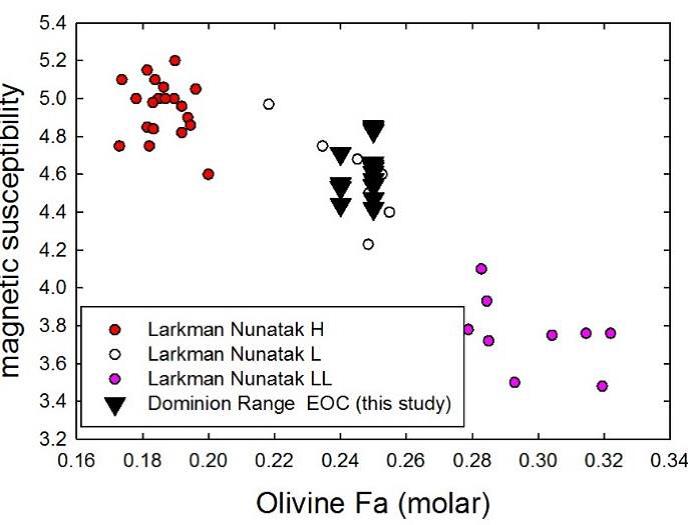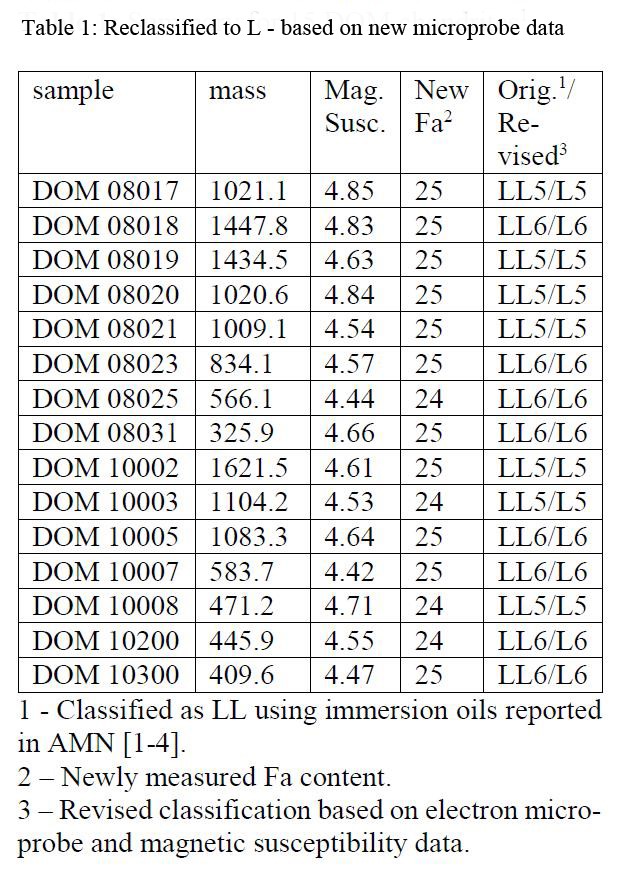Program News
Curator Comments
Kevin Righter, NASA-JSC
This newsletter reports 180 new meteorites from the 2012, 2013, and 2015 ANSMET seasons from Larkman Nunatak (LAR12), and the Miller Range (MIL13 and MIL15). Meteorites include 3 CK, 3 CM1, 15 CM2, 2 CV3, 1 CO3, 1 CR2 carbonaceous chondrite, 6 enstatite chondrites, 1 eucrite, 1 mesosiderite, and 1 ureilite.
With this newsletter, characterization and announcement of the 2012 (382 meteorites total) and 2013 (320 meteorites total) seasons are complete. The 2012 season collection is from GRA, GRO, GDR, LAR, PAT, SCO, and SZA and features large CO, CK, CR and CV chondrites (SZA 12430, SZA 12431, LAR 12247, and LAR 12002, respectively), EH3 chondrite (LAR 12001), diogenites (LAR 12010, 12248, 12320), howardite (LAR 12326), 3 irons (LAR 12059, 12204, and 12138), 3 shergottites (LAR 12011, 12095, and 12240), and the collections second winonaite (GRA 12510).
The 2013 season collection from the Miller Range (MIL13) features a lunar meteorite (MIL 13317), IAB iron (MIL 13013), aubrite (MIL 13004), CM1/2 chondrite (MIL 13005), and an unbrecciated eucrite (MIL 13019), as well as many others.
The diversity of materials from these two seasons is astounding and reflected in the large and steady number of requests we have received in the past several years. Speaking of numbers, with the recent field team collecting ~220 specimens, the total collected by ANSMET teams is ~22,013. Why the "~" you ask? During most field seasons, there are terrestrial samples collected and we slowly discover them as we classify all the samples. Therefore, we cannot give a specific number until all samples are classified (for example, the 2013 MIL season included 12 terrestrial samples). As of the Spring 2017 (this) newsletter, we have classified and announced 20,540 samples. And finally, just for more numbers – we have received >3,400 sample requests since 1978.
Reclassification
Over the last several years, we have been measuring magnetic susceptibility during the initial characterization of meteorites (see AMN vol. 39, no. 1). To make that data useful, and to verify what looked like a LL shower in the Dominion Range, we recently made thin sections of 15 large chondrites classified as LL, to compare to the magnetic susceptibility data. As it turns out, all 15 samples had olivine Fa contents of 24-25, which means these samples are L chondrites, not LL chondrites (see LPSC 2017 abstract # 2396). In fact, among the ~60 samples from Larkman Nunatak and Dominion Range that are part of the calibration of magnetic susceptibility versus XFa (probe data), all H chondrites had log c values > 4.9, and no LL chondrites had log c values > 4.4.
As a result, and using MS data published in AMN 39, no. 1, we have reclassified the samples listed below. We also note that there are ~140 ordinary chondrites from the 2003 season and ~990 from the 2008 season from the Dominion Range whose classification may be suspect and should be treated with caution until we verify these as well. There may be a large L shower associated with the Dominion Range and so the statistics from this region may be skewed from a regular distribution (see LPSC 2017 abstract # 2396).
Re-classified to H using magnetic susceptibility:
| Sample | AMN classification | M0 (10-3) | Mass (g) | Log χ(10-9 m3/kg) | Revised classification |
|---|---|---|---|---|---|
| DOM 10030 | L5 | 109 | 67.75 | 5.09 | H5 |
| DOM 10039 | L5 | 189 | 95.23 | 5.25 | H5 |
| DOM 10051 | L5 | 225 | 197 | 5.22 | H5 |
| DOM 10052 | L5 | 189 | 147.72 | 5.14 | H5 |
| DOM 10055 | L5 | 115 | 67.84 | 5.11 | H5 |
| DOM 10056 | L5 | 62.7 | 43.15 | 4.96 | H5 |
| DOM 10072 | L6 | 39.8 | 17.86 | 5.04 | H6 |
| DOM 10074 | L6 | 43.2 | 14.37 | 5.15 | H6 |
| DOM 10076 | L6 | 41.6 | 18.5 | 5.04 | H6 |
| DOM 10078 | L5 | 39.2 | 14.13 | 5.12 | H5 |
| DOM 10086 | L6 | 46.2 | 23.61 | 4.99 | H6 |
| DOM 10089 | LL5 | 84.5 | 21.95 | 5.28 | H5 |
| DOM 10149 | L5 | 110 | 61.01 | 5.12 | H5 |
| DOM 10160 | L6 | 16.3 | 5.94 | 5.07 | H6 |
| DOM 10164 | L6 | 27.6 | 11.31 | 5.05 | H6 |
| DOM 10167 | L6 | 5.6 | 2.49 | 4.94 | H6 |
| DOM 10217 | L5 | 35.7 | 18.61 | 4.97 | H5 |
| DOM 10228 | L6 | 71.5 | 59.28 | 4.94 | H6 |
| DOM 10234 | L6 | 28 | 13.72 | 4.98 | H6 |
| DOM 10235 | L6 | 19.4 | 9.07 | 4.98 | H6 |
| DOM 10237 | L6 | 22.4 | 10.18 | 5 | H6 |
| DOM 10246 | LL6 | 143 | 79.4 | 5.17 | H6 |
| DOM 10247 | L6 | 75.9 | 43.8 | 5.04 | H6 |
| DOM 10260 | LL5 | 63.5 | 34.82 | 5.01 | H5 |
| DOM 10270 | L6 | 4.85 | 2.06 | 4.95 | H6 |
| DOM 10293 | L6 | 69.2 | 41.23 | 5.01 | H6 |
| DOM 10295 | L5 | 73.2 | 42.19 | 5.03 | H5 |
| DOM 10298 | L6 | 99.5 | 46.17 | 5.14 | H6 |
| DOM 10370 | L6 | 68.1 | 18.33 | 5.26 | H6 |
| DOM 10371 | L6 | 77.1 | 24.64 | 5.2 | H6 |
| DOM 10682 | L6 | 84.2 | 40.44 | 5.1 | H6 |
| DOM 10686 | L6 | 209 | 181.6 | 5.13 | H6 |
Re-classified to L using magnetic susceptibility:
| Sample | AMN classification | M0 (10-3) | Mass (g) | Log χ(10-9 m3/kg) | Revised classification |
|---|---|---|---|---|---|
| DOM 10032 | LL6 | 36.7 | 56.31 | 4.66 | L6 |
| DOM 10033 | LL6 | 95.3 | 124.11 | 4.88 | L6 |
| DOM 10035 | LL6 | 66 | 87.78 | 4.81 | L6 |
| DOM 10036 | LL6 | 47.5 | 81.3 | 4.68 | L6 |
| DOM 10037 | LL6 | 40.5 | 48.46 | 4.74 | L6 |
| DOM 10038 | LL6 | 57.5 | 79.29 | 4.77 | L6 |
| DOM 10053 | LL6 | 48.9 | 93.24 | 4.66 | L6 |
| DOM 10054 | LL6 | 48.2 | 77.71 | 4.7 | L6 |
| DOM 10057 | LL6 | 42 | 67.03 | 4.68 | L6 |
| DOM 10058 | LL6 | 62.3 | 67.88 | 4.84 | L6 |
| DOM 10060 | LL6 | 26.9 | 42.31 | 4.59 | L6 |
| DOM 10061 | LL6 | 21.4 | 40.63 | 4.5 | L6 |
| DOM 10062 | LL6 | 22 | 21.37 | 4.71 | L6 |
| DOM 10063 | LL6 | 22.9 | 20.48 | 4.74 | L6 |
| DOM 10065 | LL6 | 28.3 | 26.98 | 4.73 | L6 |
| DOM 10066 | LL6 | 29.3 | 28 | 4.73 | L6 |
| DOM 10067 | LL6 | 14.4 | 19.62 | 4.56 | L6 |
| DOM 10068 | LL6 | 17.8 | 23.95 | 4.57 | L6 |
| DOM 10070 | LL6 | 8.6 | 12.63 | 4.5 | L6 |
| DOM 10073 | LL6 | 8.88 | 8.88 | 4.65 | L6 |
| DOM 10075 | LL6 | 15 | 22.046 | 4.53 | L6 |
| DOM 10079 | LL6 | 16.7 | 23.25 | 4.56 | L6 |
| DOM 10081 | LL6 | 36.2 | 36.26 | 4.76 | L6 |
| DOM 10082 | LL6 | 32.7 | 33.95 | 4.73 | L6 |
| DOM 10083 | LL6 | 26 | 28.31 | 4.68 | L6 |
| DOM 10084 | LL5 | 14.6 | 17.16 | 4.62 | L5 |
| DOM 10087 | LL6 | 30 | 45.15 | 4.62 | L6 |
| DOM 10140 | LL5 | 55.3 | 223.77 | 4.6 | L5 |
| DOM 10143 | LL6 | 58.3 | 124.56 | 4.67 | L6 |
| DOM 10144 | LL6 | 45.4 | 80.66 | 4.67 | L6 |
| DOM 10145 | LL6 | 33.5 | 71.35 | 4.56 | L6 |
| DOM 10146 | LL6 | 27.9 | 42.44 | 4.61 | L6 |
| DOM 10148 | LL6 | 39.4 | 54.51 | 4.7 | L6 |
| DOM 10150 | LL6 | 24.2 | 23 | 4.72 | L6 |
| DOM 10151 | LL6 | 34.4 | 31.93 | 4.77 | L6 |
| DOM 10152 | LL6 | 27.6 | 34.26 | 4.65 | L6 |
| DOM 10153 | LL6 | 20.2 | 35.55 | 4.51 | L6 |
| DOM 10154 | LL5 | 27.1 | 27.33 | 4.71 | L5 |
| DOM 10155 | LL5 | 34.5 | 52.95 | 4.65 | L5 |
| DOM 10156 | LL6 | 32.5 | 36.2 | 4.71 | L6 |
| DOM 10157 | LL5 | 32.7 | 23.93 | 4.84 | L5 |
| DOM 10162 | LL6 | 12.8 | 14.7 | 4.62 | L6 |
| DOM 10163 | LL6 | 9.64 | 10.38 | 4.63 | L6 |
| DOM 10166 | LL6 | 11.8 | 11.3 | 4.68 | L6 |
| DOM 10168 | LL6 | 11.4 | 14 | 4.59 | L6 |
| DOM 10169 | LL6 | 12.2 | 15 | 4.59 | L6 |
| DOM 10181 | LL6 | 8.76 | 8.73 | 4.65 | L6 |
| DOM 10182 | LL5 | 11.6 | 10.03 | 4.72 | L5 |
| DOM 10184 | LL6 | 20.3 | 30.03 | 4.55 | L6 |
| DOM 10185 | LL6 | 16.9 | 21.06 | 4.6 | L6 |
| DOM 10210 | LL5 | 29.9 | 36 | 4.68 | L5 |
| DOM 10212 | LL5 | 25.9 | 25.39 | 4.72 | L5 |
| DOM 10214 | LL5 | 17 | 21.42 | 4.6 | L5 |
| DOM 10216 | LL5 | 33.3 | 33.67 | 4.74 | L5 |
| DOM 10218 | LL5 | 24.1 | 33.8 | 4.6 | L5 |
| DOM 10219 | LL5 | 9.92 | 11.2 | 4.61 | L5 |
| DOM 10220 | LL6 | 47 | 78.87 | 4.69 | L6 |
| DOM 10221 | LL6 | 35.3 | 52.2 | 4.66 | L6 |
| DOM 10222 | LL6 | 28.1 | 46.76 | 4.59 | L6 |
| DOM 10223 | LL6 | 33.6 | 49.76 | 4.65 | L6 |
| DOM 10224 | LL6 | 43.5 | 49.55 | 4.76 | L6 |
| DOM 10225 | LL6 | 34 | 60.04 | 4.61 | L6 |
| DOM 10226 | LL6 | 27.8 | 32.7 | 4.67 | L6 |
| DOM 10227 | LL6 | 24.8 | 44.43 | 4.55 | L6 |
| DOM 10229 | LL6 | 46.1 | 56.34 | 4.76 | L6 |
| DOM 10230 | LL6 | 13.1 | 17.83 | 4.55 | L6 |
| DOM 10233 | LL6 | 8.58 | 11.34 | 4.54 | L6 |
| DOM 10236 | LL6 | 16.3 | 19.23 | 4.62 | L6 |
| DOM 10238 | LL6 | 8.94 | 9.23 | 4.64 | L6 |
| DOM 10239 | LL6 | 14.7 | 18.83 | 4.58 | L6 |
| DOM 10240 | LL6 | 56.1 | 110.53 | 4.68 | L6 |
| DOM 10241 | LL6 | 51.6 | 102.54 | 4.66 | L6 |
| DOM 10242 | LL6 | 43.5 | 72.7 | 4.67 | L6 |
| DOM 10243 | LL6 | 34.8 | 52.38 | 4.65 | L6 |
| DOM 10244 | LL6 | 56.8 | 103.15 | 4.7 | L6 |
| DOM 10245 | LL6 | 35.3 | 45.95 | 4.69 | L6 |
| DOM 10249 | LL6 | 46.5 | 64.14 | 4.73 | L6 |
| DOM 10261 | LL6 | 36.3 | 36.29 | 4.76 | L6 |
| DOM 10263 | LL6 | 21.7 | 30.78 | 4.57 | L6 |
| DOM 10264 | LL6 | 27.1 | 21.31 | 4.8 | L6 |
| DOM 10265 | LL6 | 17 | 16.88 | 4.69 | L6 |
| DOM 10266 | LL6 | 30.9 | 28.35 | 4.75 | L6 |
| DOM 10267 | LL6 | 26.2 | 33.53 | 4.64 | L6 |
| DOM 10268 | LL5 | 22.6 | 36.51 | 4.55 | L5 |
| DOM 10269 | LL6 | 36.9 | 36.62 | 4.77 | L6 |
| DOM 10272 | LL5 | 5.08 | 5.64 | 4.58 | L5 |
| DOM 10274 | LL5 | 8.35 | 7.94 | 4.67 | L5 |
| DOM 10276 | LL5 | 9.41 | 9.36 | 4.66 | L5 |
| DOM 10277 | LL5 | 12.8 | 12.42 | 4.68 | L5 |
| DOM 10279 | LL5 | 5.61 | 4.67 | 4.7 | L5 |
| DOM 10290 | LL6 | 36.4 | 48.31 | 4.69 | L6 |
| DOM 10291 | LL6 | 33.7 | 39.56 | 4.71 | L6 |
| DOM 10292 | LL6 | 44.2 | 44.86 | 4.79 | L6 |
| DOM 10294 | LL6 | 47.2 | 45.44 | 4.82 | L6 |
| DOM 10296 | LL6 | 38.9 | 48.63 | 4.72 | L6 |
| DOM 10297 | LL6 | 24.1 | 28.88 | 4.64 | L6 |
| DOM 10372 | LL6 | 16.1 | 19.45 | 4.61 | L6 |
| DOM 10373 | LL6 | 20.2 | 30.39 | 4.54 | L6 |
| DOM 10374 | LL6 | 32.3 | 57.07 | 4.6 | L6 |
| DOM 10375 | LL5 | 52.6 | 73.07 | 4.75 | L5 |
| DOM 10376 | LL5 | 56.2 | 50.6 | 4.87 | L5 |
| DOM 10377 | LL6 | 44.6 | 41.88 | 4.82 | L6 |
| DOM 10379 | LL6 | 46.3 | 91.47 | 4.64 | L6 |
| DOM 10432 | LL6 | 4.66 | 8.75 | 4.38 | L6 |
| DOM 10436 | LL5 | 8.4 | 14 | 4.45 | L5 |
| DOM 10437 | LL5 | 9.62 | 15.9 | 4.46 | L5 |
| DOM 10438 | LL5 | 14 | 23.38 | 4.48 | L5 |
| DOM 10443 | LL5 | 26.7 | 46.1 | 4.57 | L5 |
| DOM 10444 | LL6 | 26.7 | 42.29 | 4.59 | L6 |
| DOM 10446 | LL5 | 21.1 | 35.38 | 4.53 | L5 |
| DOM 10447 | LL5 | 37.8 | 78.54 | 4.59 | L5 |
| DOM 10448 | LL6 | 22.3 | 55.71 | 4.45 | L6 |
| DOM 10449 | LL5 | 57.7 | 89.64 | 4.74 | L5 |
| DOM 10457 | LL5 | 31 | 62.33 | 4.56 | L5 |
| DOM 10460 | LL6 | 37.8 | 44.38 | 4.73 | L6 |
| DOM 10461 | LL6 | 34.9 | 80.48 | 4.55 | L6 |
| DOM 10462 | LL6 | 22.3 | 49.46 | 4.47 | L6 |
| DOM 10463 | LL6 | 44.1 | 60.77 | 4.72 | L6 |
| DOM 10464 | LL6 | 51 | 41.19 | 4.88 | L6 |
| DOM 10465 | LL6 | 37 | 40.21 | 4.74 | L6 |
| DOM 10466 | LL6 | 20.7 | 15.5 | 4.81 | L6 |
| DOM 10468 | LL6 | 19.5 | 24.08 | 4.61 | L6 |
| DOM 10545 | LL6 | 19.95 | 14.2 | 4.82 | L6 |
| DOM 10680 | LL6 | 25.7 | 59.58 | 4.49 | L6 |
| DOM 10681 | LL6 | 43.8 | 71.09 | 4.68 | L6 |
| DOM 10683 | LL6 | 37.1 | 50.69 | 4.69 | L6 |
| DOM 10684 | LL6 | 40.9 | 57.79 | 4.7 | L6 |
| DOM 10685 | LL6 | 48.4 | 57.44 | 4.78 | L6 |
| DOM 10687 | LL6 | 48.7 | 73.92 | 4.72 | L6 |
| DOM 10688 | LL6 | 79.6 | 156.11 | 4.75 | L6 |
| DOM 10689 | LL6 | 89.9 | 210.59 | 4.81 | L6 |
Updates to JSC webpage:
The bibliography of US Antarctic Meteorites has been updated to reflect 59 new publications from 2016. In addition, search options have been added, including ability to search by author, text, or year; users also have an option to output the search to an excel file.
The structure of the webpage has changed slightly to reflect updates and additions. The collection excel sheet has been updated to include all samples through AMN 39, no. 2, the list of bandsawed samples has been updated, and portions have been updated to reflect our current request, review, approval, allocation, and loan agreement processes.
Reminder to acknowledge samples received from NASA-JSC
When publishing results of your research, please include the split numbers used in the research.
We also request that scientists use the following acknowledgement statement when reporting the results of their research in peer reviewed journals: “US Antarctic meteorite samples are recovered by the Antarctic Search for Meteorites (ANSMET) program which has been funded by NSF and NASA, and characterized and curated by the Department of Mineral Sciences of the Smithsonian Institution and Astromaterials Curation Office at NASA Johnson Space Center.” Such an acknowledgement will broaden the awareness of the funding mechanisms that make this program and these samples possible.
We suggest you find out how to acknowledge samples received from all the collections/museums from which you have received materials so that all the institutions making samples available to you receive proper credit and acknowledgement.
ANSMET 2016 – 2017 Field Season
Jim Karner, Ralph Harvey and John Schutt
The 2016–17 field season was marked by a major change in plans, and then a major delay getting into the field, ugh! ANSMET had planned to send a group of eight to work out of the Shackleton Glacier Camp (SHG) in the southern TransAntarctic Mountains. From there the group would split into two teams of four, and each team would search for and recover meteorites from nearby ice fields. That plan was not meant to be, however, because by mid-December the SHG was experiencing a serious shortage of fuel and logistical resources, and would be unable to support the ANSMET team. We quickly descoped our field season (so as to not be cancelled outright) and planned for a trip to the Elephant Moraine (EET) icefields, which could be supported out of McMurdo Station. ANSMET had recovered over 2000 meteorites from EET in the past, but the area had not been visited since 1999 due to extensive snow cover. The new season plan would allow ANSMET to recover meteorites from previously searched and unsearched areas of the vast icefields at EET (Figure 1).
The team was ready for put–in to EET on December 15, but a slew of bad weather at McMurdo and/or EET delayed John Schutt, Jani Radebaugh, Brian Rougeux, and Minako Righter until December 29. Another week of bad weather kept Jim Karner and Alex Meshik in McMurdo until Jan. 3. The full team was at EET from Jan. 4 to Jan. 19, but during that time the team was limited to only seven full days of searching out of a possible 14 working days. It turns out EET has a lot of bad weather - seriously windy, cold, lots of blowing snow! Anyway, the team worked hard when it could and employed recon and systematic searching throughout the vast EET icefields. The team recovered a total of 173 meteorites; that, added to Duck Mittlefelhdt and John Schutt's recon efforts earlier in the season, made for a grand total of 219 meteorites recovered for the 2016–17 field season. A smaller quantity than in most ANSMET seasons, but hopefully they will be of high quality!
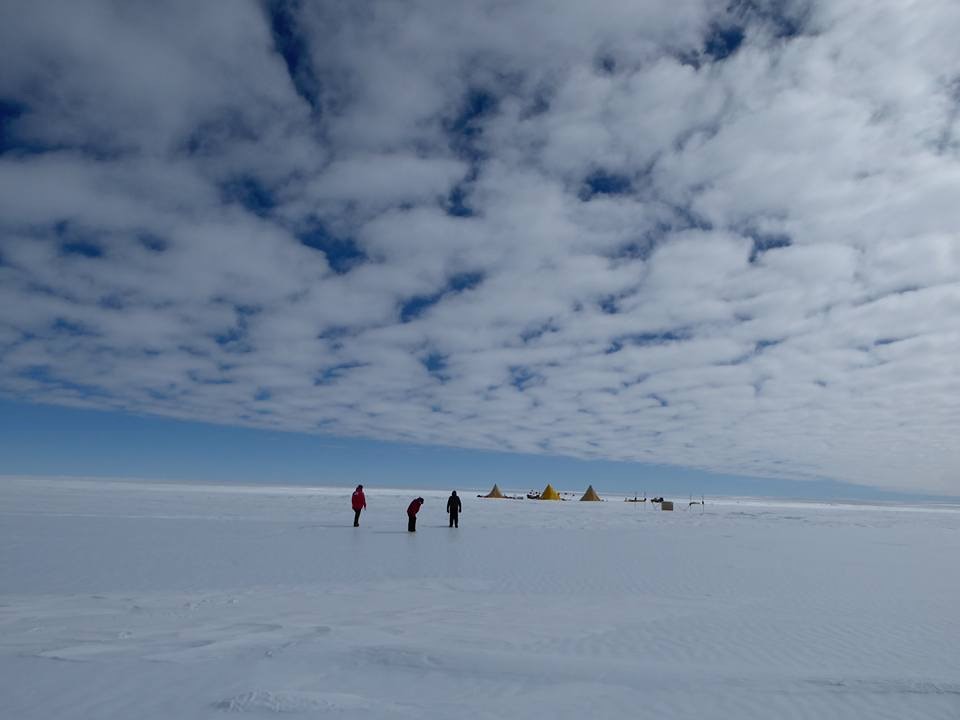
Figure 1. ANSMET team members search for meteorites near their camp at EET.
Report from the Smithsonian
Cari Corrigan, Geologist (Dept. of Mineral Sci.)
All is well in the Division of Meteorites at the Smithsonian. We are pleased to report that our new electron microprobe (a JEOL JXA 8530f Hyperprobe) arrived on November 1st, 2016, and is built and in the initial stages of testing. This new instrument will be used to classify the Antarctic Meteorites and will provide us with state of the art capabilities to do so. Here's hoping that all of the microprobe analyses in the Fall newsletter come to you from the new instrument!
We have two new volunteers on board with the Division of Meteorites. Greg Polley, who has a Masters Degree in Geology from the University of Maryland and has been working to complete the inventory of photographs of every Antarctic meteorite thin section in our collection. Doug Ross, a local musician and meteorite enthusiast, has recently come on board as well, and has been great about lending a hand while learning more about meteorites. We are happy to have them here, and appreciate their help and enthusiasm!
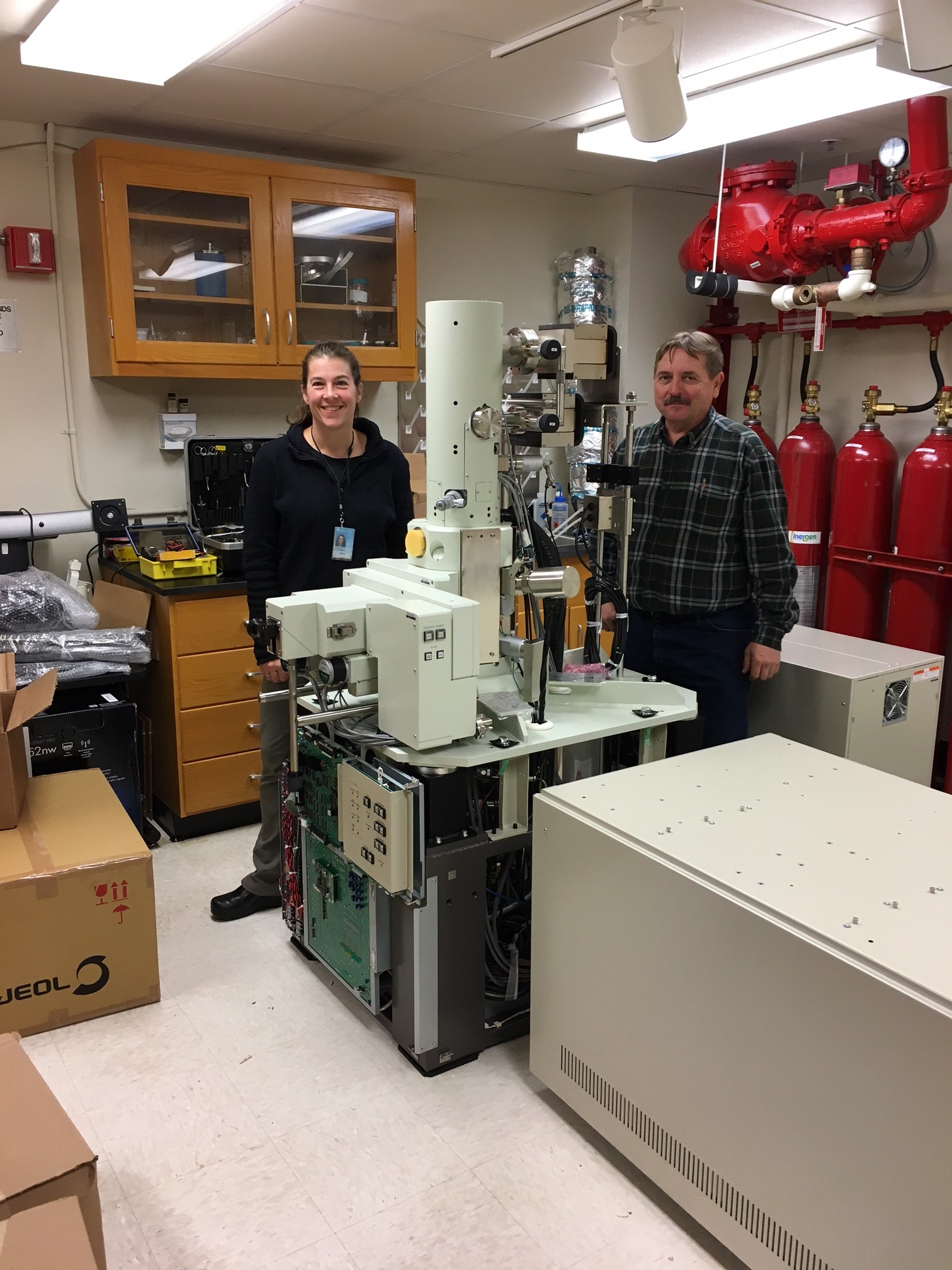
Cari Corrigan and Tim Rose and the HYPER PROBE

Greg Polley - SI Volunteer
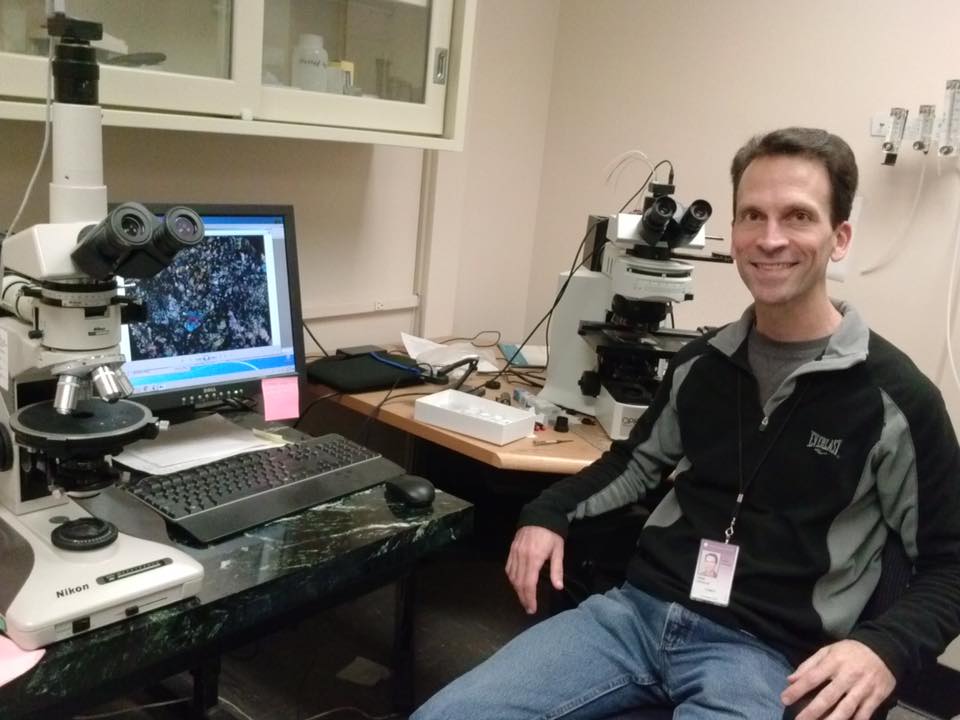
Doug Ross - SI Volunteer

